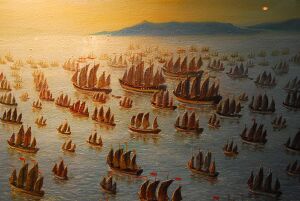Daxian Polynesian Wars
| Daxian Polynesian Wars | |||||||
|---|---|---|---|---|---|---|---|
 A depiction of an imperial fleet on its way to the Siege of Dun-Kurrengev in Sarolasta | |||||||
| |||||||
| Belligerents | |||||||
|
|
| ||||||
The Daxian Polynesian Wars (Daxian:潮汐之战) were a series of maritime conflicts centered on the Ocean of Cathay and the Polynesian Sea between various western colonial powers, local independent states and the Qian dynasty. The main reason for the start of the conflict was the discovery and colonization of Peratra by the Qian dynasty and its desire to forestall the expansion of other sea faring powers into the western Cathay area. The war soon transitioned into a Daxian effort to outright expel other powers from various possessions; the Harmonious Flotilla Invincible nicknamed the Left Trident of the Qian was the empire's main military force engaged in battle. Peace and trade normality would start to return to the area with the signing of several peace agreements with Kiravia and Burgundie in 1721 and in 1728 with the signing of the Truce of Caserges with the Imperium. The Qian dynasty had failed in the most important goal of its sea campaigns and the truce cemented the status quo antebellum; nonetheless the dynasty and its proxies remained dominant in the western end of the southern route.
During the course of the conflict several independent polities were snuffed out by Daxia or had their populations supplanted by settlers from the mainland in behavior similar to western colonizers. The ultimate failure of the campaign would become the historical justification cited one hundred and fifty years later to commence building the Great Arsenal; a large and modernized war fleet to secure Daxia's dominion in the high seas.
Background
The start of Qian dynasty expansion on the seas began with Xi Haifong's discovery of Peratra in the late 16th century. Successive emperors dreamt of building an empire across the seas much as the Bergendii were doing in western Audonia, and use the resources garnered to push back against the latter. Even as Emperor Yuanjian was pushing for the rapid subjugation of the tribes of Peratra, he and his court planned for more expansion. The encounter in 1615 with Gabo de Pogiano was an entirely unwelcome development, men wearing clothing and sailing vessels not altogether dissimilar to the hated Bergendii themselves. This initial contact ignited fierce debates between court officials, eventually two factions coalesced: a hardline faction advocating destroying the Pelaxian expedition and a cautious faction counseling restraint. In this initial debate, the emperor sided with the cautious courtiers and Pogiano was received and promises of peaceful trade exchanged; an expedition of Qian ships would even be guided back to Pelaxian shores. As more foreign merchants and embassies from powers further away, Qian paranoia flared again; the budding South seas trading company was ordered to being outfitting warships in preparation of a confrontation, imperial forces did the same. The recently appointed Admiral-eunuch Zhu Bolin built a large armada of one hundred and twenty ships; composed of 70 galleys, 30 galleons and other smaller ships. Zhu Bolin's force was named the Right Trident of the Qian or the Fleet of the Eastern Tides. A premature attempt at securing extra positions on the Polynesian Sea by over eager and uprepared elements resulted in the Tolu Manatu Incident but ultimately this fiasco did nothing to deter the court from its decided course of action. Qian military planners decided to attack Kiravian Sarolasta first, its position in the northern Polynesian would serve as the northern anchor for a 'naval net' blocking access to the Ocean of Cathay; the second anchor would be Zhijun which was already under Daxian control.